BLOG
Home » The Many Advantages of Portable Hearing Loops – Hearing Loop

Portable Hearing Loops
Why consider portable hearing loops? When it comes to providing a comfortable, comprehensive experience for those hard of hearing, the type of hearing loop setup you install at your place of business can have a big impact.
Get it wrong and users of the system may suffer with overspill – sounds intruding from nearby locations- distorted audio and, overall, an unpleasant and often excluding experience.
Get it right and there will be a seamless, tailored environment for those who access the hearing loop, with clarity and functionality assured.
What’s more, a portable hearing loop can operate across multiple spaces with different needs and acoustic properties.
What this means for the user is a system that supports their needs, no matter the environment and no matter the scenario they find themselves in.
It’s important for businesses and organisations – no matter what the on-site activities are – to provide an environment that is both welcoming and caters to the needs of those who are hard of hearing.
Failing to do so shows a lack of planning and preparedness and could even mean those who are hard of hearing actively avoid the space.
For businesses, this means lost trade and an unwelcome reputation.
Portable hearing loops make it easy to avoid these issues but there are additional benefits over a traditional fixed system.

Portable Hearing Loop Systems Explained
A portable hearing loop is the ideal alternative to a fixed system, offering a raft of advantages while still doing everything that your hearing loop system needs to do.
Essentially, any space that has multiple rooms and sees different uses can benefit from a portable hearing loop installation.
The system offers a great range of flexibility and mixed-use capabilities, while still maintaining a clear, strong signal and enabling the user to go about their business unhindered.
Busy environments like hotels, for example, can benefit from a portable hearing loops.
This type of hearing loop is suitable for use in a number of spaces, from the check-in desk to individual rooms, with each area covered but not producing overspill into those nearby.
For spaces that might be pressed into service for a number of different uses through the month, this versatility is ideal.
Even better, a portable hearing loop system is quick and easy to install.
This means minimal disruption to your business or space, and great results for users.
Spaces like universities, colleges and schools are also the ideal environments for portable hearing loops.
Users are able to move about the site as they need, without the fear of losing auditory clarity or finding themselves besieged by unexpected inputs during a key moment of a lecture or seminar.
Future Proofing Your Portable Hearing Loop System Investment
One of the main issues many businesses or public spaces face when considering a hearing loop system is how much it will cost – not just now but going forwards as well.
A fixed system can be expensive to install and, if you decide to move premises, you will need to invest in another fixed system at the new location.
Not so with a portable hearing loop system.
If your business expands, you can take your portable system with you, set it up and you’re good to go.
This means you’ll make a one-time investment in a portable hearing loop system with no further need for repeat expenditure if you do relocate to new premises.
In terms of disruption, a portable hearing loop system completely offsets the need for installation, whereas the same cannot be said of a fixed system.
A portable hearing loop system is also much easier to modulate and upscale than a fixed hearing loop option.
You can start with a simple one or two-pack configuration and then add an extra pen if, for example, you chose a Phonak Roger System, as needed.
This means quick, easy installation and the ability to take your portable loops hearing system with you when your business expands – making it a much safer bet in terms of future proofing your investment than a fixed option.
What Are Blind Commentary Hearing Loop Systems?
When those with sight issues visit certain environments – such as a sports stadium – there are various factors at play that can make enjoying the experience difficult.
Environments like this are full of different types of noise, much of it extremely loud and, if someone has reduced sight capabilities or blindness, this can mean a disconnect from what is happening.
This is exactly where a blind commentary portable hearing aid loop system can help.
A portable hearing loops system such as the Roger System can be teamed with a transmitter on site to offer blind commentary.
The user has details of the action on-pitch fed into their ears.
This is often more descriptive than television or radio commentary, making the experience more immersive for the user. But this is not all a blind commentary loop system offers.
Via the use of expanders and repeaters, the blind commentary loop system can cover the entire ground.
This means coverage for places like boardrooms, turnstiles, hospitality areas and anywhere else a user might need insight into their surroundings.
At a low cost, a big space like a football ground can provide everything the hard of hearing and the sight impaired need to fully enjoy their day out.

What Are the Benefits of Portable Hearing Loop Systems?
Portable hearing loops as a system provide an enormous amount of flexibility for users and the business or space that uses them.
Users know that they have access to a hearing loop system that gives them the ability to go wherever they want without needing to think about coverage or overspill from nearby spaces.
As a business, you know that you have a robust, scalable hearing loop system that delivers excellent return on investment and that is future proofed.
In terms of application and flexibility of use, a portable induction loop hearing system like the Roger Pen set up offers multiple functions and benefits all in one.
A Roger Pen behaves as a directional mic when spoken into but, when placed on its side, becomes an omni-directional microphone which completely changes its use.
At the same time, a Roger Pen placed into a docking station can connect to an audio feed – which could be a television, audio input or a PA system – and thus provide additional functionality.
For many spaces- whether business or public – this type of system can provide everything you need to ensure quality audio input for users.
And it’s all totally portable and scalable to your needs.
Fixed System Vs. Portable Plug & Play – What Should You Choose?
Two of the major factors that many spaces face when installing a fixed hearing loop system are disruption and cost.
A fixed hearing loop system requires room-by-room installation.
This involves installing and running cables, putting an amplifier in place and then configuring and connecting audio inputs.
-
Offer!

PL1/K1 Portable Hearing Loop & Shelf (1.2m2)
£241.24Original price was: £241.24.£156.00Current price is: £156.00. exl VATSaving £85.24 each exl VAT
SKU: PL1/K1
Add to cart -
Offer!

PL1/K3 Portable Hearing Loop & Carry Case (1.2m2)
£411.86Original price was: £411.86.£266.00Current price is: £266.00. exl VATSaving £145.86 each exl VAT
SKU: PL1/K3
Add to cart -

PL1/K1 SSB Portable Hearing Loop Self Service Bundle
£206.00 exl VATSKU: PL1/K1 SSB
Add to cart
If a room requires a confined, crossover-less installation, this means installing a more expensive phase shifting loop amplifier and specialised cabling design.
Therefore, this process is even more labour intensive, time consuming and expensive than a regular fixed hearing loop set up.
A portable system, on the other hand, simply requires the right components and you can plug in and play.
No drilling, no lengthy installation – just a system that does what you need and works for users.
Even in cases where overspill reduction is a must, portable hearing loops can provide this in no time at all.
All you need for a simple, easy set up is a two-pack system which can then be configured to be confined only to that room.

Calculating Hearing Loop Demand and Return on Investment
Often, many businesses and commercial or public spaces are unsure if they are obligated to provide a hearing loop system for their property.
It is in fact a legal requirement under the Equality Act.
This legislation says that service providers need to make a reasonable adjustment, which means that you must install one if having “appropriate” induction loop equipment can be deemed to be a reasonable adjustment.
In short, if those with hearing loss are likely to use your premises, you must make an investment in a hearing loop system to be legally compliant.
Of course, meeting a legal requirement isn’t the only reason to provide a quality hearing loop system as it pays to think in terms of customer satisfaction and the overall customer experience your organisation offers to those hard of hearing too.
This, in and of itself, can provide a compelling case for hearing loop installation and go a long way to offering a positive ROI.
Imagine you own a restaurant or bar.
You might judge that demand is low for hearing loop facilities.
The reality is that many people who are deaf or suffer with hearing loss often find the restaurant environment either completely unequipped for their needs or at best, fitted with a sub-standard system.
What this means for the person in question is a noisy, audio-diverse environment that is often difficult to navigate.
When this person finds a restaurant that has a quality, well-planned hearing loop system, they are not only more likely to enjoy a superior experience and return themselves but also to spread the word.
This means an enhanced reputation for the business and increased trade – all for the relatively low cost of a portable hearing loop system.
Infrared Vs. Radio Frequency – What’s the Difference?
In certain situations, there is a need to maintain the confidentiality of information given by someone who is deaf or hearing impaired.
A good example would be in a courtroom.
In situations like this, an infrared hearing loop is often used because the system is line of sight only.
What this means is that if someone or something disrupts the infrared beam travelling from the user’s neck loop to the system’s receiver, the signal – and thus audio for the user – will degrade.
While this is good for a confidential, cloistered setting, this is obviously not so good when it comes to busy environments.
This is where a radio frequency portable hearing aid loop can be useful.
The RF unit is placed under the user’s clothes if they desire and a good system – like the Phonak Roger System– can offer just as much security and confidentiality as an infrared option.
A radio frequency loop offers quicker installation as a plug and play system and all the same options as an infrared set up for less cost and better performance.
While infrared does have its uses, for most businesses and organisations a Phonak Roger System has more benefits, less drawbacks and is simply the smarter, cheaper option.

What Maintenance Costs Should You Expect For Portable Hearing Loops?
Although a traditional fixed loop system can require a fairly hefty amount of maintenance and upkeep with all of the associated costs, a portable system is much less hassle.
In fact, you should expect to spend significantly less to maintain a portable hearing loop.
The main consideration in portable hearing loop maintenance is ensuring all components are properly charged.
This is an easy issue to take care of with a few simple processes and rules in place.
A simple check with a loop listener can assess the charge quickly and easily.
If it’s found to be low, portable hearing loops components take just a couple of hours to reach full charge.
A good portable system that is well maintained and looked after should run for up to five years with minimal issues.
If you need or want a dedicated maintenance check, the costs will be low – around £50 – and don’t take very long at all.
In a fixed system, flat maintenance fees usually apply and come in at around £640.
This involves travel to the site and maintenance of up to three rooms so costs will rise if you have additional areas that require maintenance.
In addition, these rooms will be out of action as maintenance takes place.
The key is to not assess only the initial buy price, but also to consider ongoing operational costs.
And, in this area, it’s clear that portable hearing loop systems win hands down.
The Final Assessment: Are Portable Hearing Loops Worth It?
As we have seen, portable hearing loops offer a huge range of benefits, outstripping fixed hearing loop systems in a number of areas.
In terms of flexibility of use for the business and the user, there really isn’t much of a comparison to be had.
A portable system affords you the ability to provide clear, quality hearing loop facilities to users across a broad range of environments – with the ability to upscale and modulate the system as you see fit.
Portable hearing loop systems can provide robust coverage in dining rooms, restaurants, boardrooms, and any other space you might need to consider.
Additionally, you only need to invest once in a portable hearing loop system, so you can take it with you if you move to a new space.
A fixed hearing loop system cannot provide this flexibility, so you’ll have to pay again for another system in the new premises.
And when it comes to the actual installation process, a portable system is a true plug and play option, whereas a fixed system requires installation and, thus, disruption to your everyday activities.
Maintenance is another area where portable hearing loop systems win out.
With portable hearing loops, the system is easier and cheaper to maintain than a fixed system, even if you bring in a professional.
Ultimately, a portable hearing loop system provides all the functionality and coverage you need, minus the installation and maintenance costs of a fixed system.
Moreover, a portable loop is more flexible in allowing you to expand and modulate the system and, ultimately, provides greater return on investment with better overall capabilities.
Book A Consultation With The Specialists At HearingLoop.co.uk
If you’d like to find out more about installing a portable hearing loops in your place of business, call 0114 2357 717 or email us at info@hearingloop.co.uk to get connected to one of our hearing loop experts.
Categories
- Assisted Living (3)
- Communication (4)
- Compliance (2)
- Cordless Telephones (3)
- Course (1)
- Design Survey (1)
- Features & Benefits (1)
- Features & Benefits (1)
- General Hearing (5)
- Hearing Loop Systems (14)
- Hearing Loop Uses (4)
- Hearing Loops (31)
- Installation & Commissioning (3)
- Installation & Commissioning (1)
- Portable Hearing Loop (3)
- Portable Hearing Loops (15)
- Service & Maintenance (1)
- Service & Maintenance (2)
- Uncategorized (2)
Recent Posts
- Top Reasons Every Business Needs an Induction Loop System
- Hearing Loops And Mental Health
- 10 Remarkable Benefits of Using the PL1/K1 Portable Hearing Loop System
- The Ultimate Guide to Phonak Roger ON: How It Works and Who It’s For
- The PL1/K1 Portable Hearing Loop: A Game-Changer for Midwives and Community Healthcare Providers




